 You were born knowing exactly how much to eat. Hunger is your body’s way of telling you that you need fuel.
You were born knowing exactly how much to eat. Hunger is your body’s way of telling you that you need fuel.
Perhaps you’ve ignored your hunger signals for so long that you’ve forgotten how to recognize it. At the same time, you may have learned to ignore the feeling of satisfaction so you eat until you’re stuffed and uncomfortable instead of stopping when you’ve had enough.
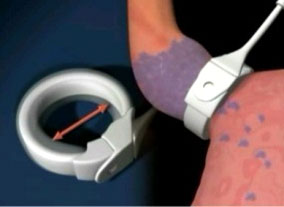 Reconnecting with your hunger signals helps you reach a healthier weight
Reconnecting with your hunger signals helps you reach a healthier weight
The Lap Band will help you by reconnecting with your instinctive signals , you can manage your eating without restrictive dieting and obsessing over every bite of food you put in your mouth.
See animation https://ow.ly/B5t0y
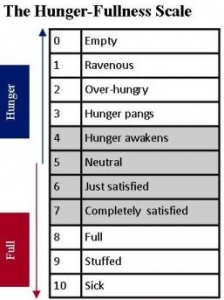 • You’ll notice you’re hungry before you get too hungry and decrease overeating.
• You’ll notice you’re hungry before you get too hungry and decrease overeating.
• Food actually tastes better when you’re physically hungry.
Hunger really is the best seasoning — so you eat less but enjoy it more.
• You’ll eat less food when you’re practicing to satisfy physical hunger than if you eat to satisfy other needs. Use mindful eating.
Trust your gut instincts
To break out of the pattern of eating on autopilot, get in the habit of asking yourself, “Am I hungry?” or “how hungry am I right now” every time you feel like eating. This simple but powerful question will help you recognize the difference between an urge to eat caused by the physical need for food from an urge to eat caused by head hunger.
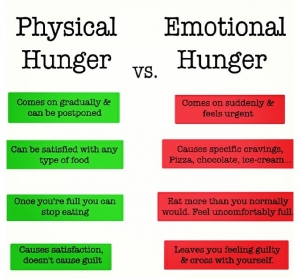 Notice that hunger is physical.
Notice that hunger is physical.
It’s not a craving, a thought or a temptation. Look for symptoms like hunger pangs, gnawing, growling, emptiness, low energy, shakiness, or headache. By focusing on hunger as your guide, you can become your own internal expert about when, what, and how much to eat.
• You’re more likely to choose foods that nourish you.
If you aren’t hungry but you’re eating because you are sad, mad or glad, what kinds of foods do you want? That’s when you’re more likely to want chocolate, cookies, chips, or other snacks and comfort foods.
• You’ll feel more satisfied
Food is great for reducing hunger but not so great for reducing boredom, stress, or other triggers.
 Food for thought
Food for thought
• What specific signs of hunger do you usually have?
• What other thoughts and feelings do you confuse with hunger at times?
• What else could you do besides eat when you feel like eating even though you’re not hungry?
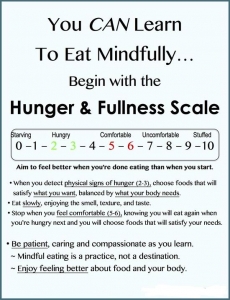 Mindful eating is a decision-making process that needs regular practice, including:
Mindful eating is a decision-making process that needs regular practice, including:
Paying attention to hunger and fullness cues
Recognizing emotional and environmental triggers for eating
Using nutrition information as a tool, not a weapon
Choosing food that reflects balance, variety, and moderation for optimal nourishment and enjoyment
Appreciating the appearance, aromas, and flavors of food
Noticing how different foods, ingredients, and quantities affect satiety, energy, and pleasure
Learning from mistakes rather than shaming, blaming, or judging
Engaging in regular, joyful physical activity
Practicing consistent self-care that decreases vulnerability to stress and unhealthy behaviors
Giving up the dichotomy of being in control or out of control, and choosing to be in charge instead
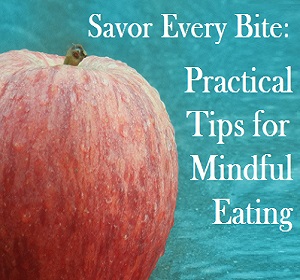 Mindful Eating
Mindful Eating
Mindful eating encompasses a variety of concepts, but at its core, it centers on how we eat rather than what we eat.
Pace
A key aspect of mindful eating is paying attention to the pace at which we eat our food. All too often, we rush through meals, eating more quickly than we should. This is often done out of habit, or because we are too distracted during meals or are rushing due to hectic, busy schedules. To eat mindfully, you would pause between taking bites, chew your food more thoroughly, and pay attention to your breathing and how full you feel.
Avoiding Distractions
Mindful eating involves staying away from life’s many distractions, including your TV, radio, computer, phone or other mobile devices. You should also refrain from eating while you drive.
Assessing Level of Hunger
Think of your hunger as ranging from 1 to 10, with 1 being absolutely starving and 10 being completely stuffed. Assess your level of hunger before you start eating and gauge this level throughout your meal to know when to stop. Your Lap Band will help you to feel full sooner. But if you are not in tune with your hunger ques you may push past the stop signal and continue to eat more then you need. With mindful eating, you are encouraged to check in with your level of hunger often. This will help you to learn how to reconnect with your instinctive signals and stop eating with less food.
Enjoying & Appreciating Food
Learning to find pleasure in eating and fully recognizing all of the senses you’re using simultaneously in the process is essential to mindful eating. Appreciate how food nourishes your body while savoring each bite. Also key is paying attention to your reactions to food without judging yourself.
Recognizing Mindless Eating Habits
Being cognizant of mindless eating behaviors (and their consequences), such as emotional eating and overeating, are crucial to mindful eating.
The goal to achieve with mindful eating with the help of your Lap Band is a healthy relationship with food and to throw out the notion of dieting. The main idea is that it can help people achieve their weight loss goals for a lifetime, rather than for a short-term period of time. When you look for the shades of grey in place of old black-and-white thinking, you’ll quickly discover how colorful your life becomes!


